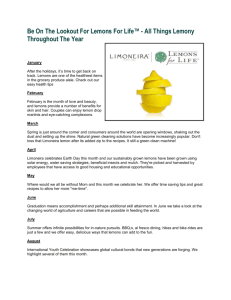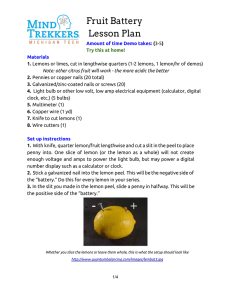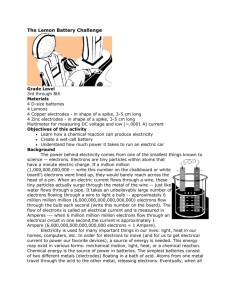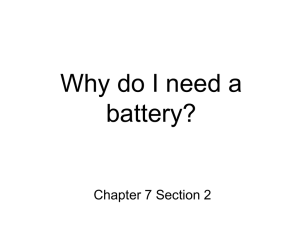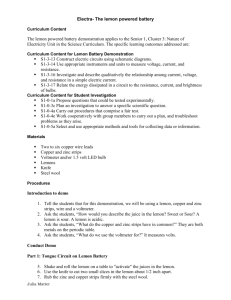Build_a_Lemon_Battery
advertisement
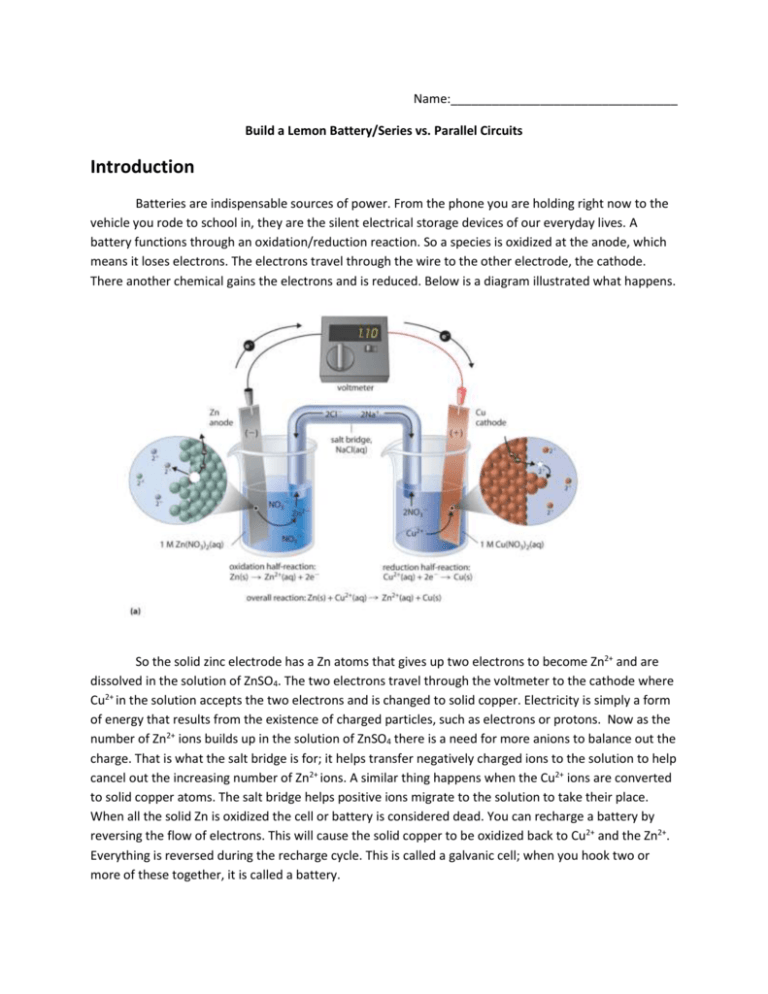
Name:_________________________________ Build a Lemon Battery/Series vs. Parallel Circuits Introduction Batteries are indispensable sources of power. From the phone you are holding right now to the vehicle you rode to school in, they are the silent electrical storage devices of our everyday lives. A battery functions through an oxidation/reduction reaction. So a species is oxidized at the anode, which means it loses electrons. The electrons travel through the wire to the other electrode, the cathode. There another chemical gains the electrons and is reduced. Below is a diagram illustrated what happens. So the solid zinc electrode has a Zn atoms that gives up two electrons to become Zn2+ and are dissolved in the solution of ZnSO4. The two electrons travel through the voltmeter to the cathode where Cu2+ in the solution accepts the two electrons and is changed to solid copper. Electricity is simply a form of energy that results from the existence of charged particles, such as electrons or protons. Now as the number of Zn2+ ions builds up in the solution of ZnSO4 there is a need for more anions to balance out the charge. That is what the salt bridge is for; it helps transfer negatively charged ions to the solution to help cancel out the increasing number of Zn2+ ions. A similar thing happens when the Cu2+ ions are converted to solid copper atoms. The salt bridge helps positive ions migrate to the solution to take their place. When all the solid Zn is oxidized the cell or battery is considered dead. You can recharge a battery by reversing the flow of electrons. This will cause the solid copper to be oxidized back to Cu2+ and the Zn2+. Everything is reversed during the recharge cycle. This is called a galvanic cell; when you hook two or more of these together, it is called a battery. You are going to create battery from a lemon. As you can see, batteries require lots of electrolytes. Lemons are acidic, meaning they have electrolytes; therefore, they can create electricity from redox reactions when you insert electrodes in them. The reactions are below: electron s Anode H+ H+ SO4 2- H2(g) SO42- Al3+ Al H+ Cl- Cathode Cu SO42- Al3+ Cl- H+ H+ H+ SO42SO42- So the unbalanced oxidation is: 𝐴𝑙(𝑠) → 𝐴𝑙 3+ + 3𝑒 − And the unbalanced reduction is: 𝐻 + + 2𝑒 − → 𝐻2 (𝑔) Procedure 1. Select two lemons, a penny, some aluminum foil, and a digital multi meter. 2. Polish the penny, but be careful not to rub off the copper coating. The more shiny the better penny can function as an electrode. 3. Insert the penny into one of the precut slits in the lemon. 4. 5. 6. 7. 8. 9. 10. 11. 12. 13. 14. 15. 16. 17. Insert the aluminum foil into the other precut slit. Record the resistance (Ω, Ohms), the voltage (V, Volts), and the current (mA, milliamps). Remember to switch the digital multimeter settings to view each value. Connect a second lemon in parallel to the first lemon (refer to diagram to see how to connect parallel vs. series circuitry). Record the resistance (Ω, Ohms), the voltage (V, Volts), and the current (mA, milliamps). Add a third lemon in parallel to the other two. Record the resistance (Ω, Ohms), the voltage (V, Volts), and the current (mA, milliamps). Disconnect all the cables. Connect two lemons in series. Record the resistance (Ω, Ohms), the voltage (V, Volts), and the current (mA, milliamps). Add a third lemon to the series ciruit. Record the resistance (Ω, Ohms), the voltage (V, Volts), and the current (mA, milliamps). Disconnect all the cables. Dispose of the lemons and clean up. Data Cell/Battery Configuration 1 lemon Voltage (V) Resistance (Ω) Current (mA) 2 lemons parallel 3 lemons parallel 2 lemons series 3 lemons series Post-Lab Questions 1. From your measurements of voltage, resistance and current in the cell and batteries, what conclusions can you draw? How is current and voltage affected in a series circuit versus a parallel circuit? 2. Which metal is the anode and which is the cathode in the lemon batteries? In which direction do the electrons flow? 3. A standard 12V automobile battery when fully charged has a terminal voltage of 12.6-12.8 V How many aluminum/copper lemon cells would be required to reach this voltage? Would you hook the cells in series or parallel to achieve 12 V? 4. If starting a particular car requires 600 amps (600,000 mA), how many of your aluminium/copper lemon cells would be needed to construct a battery capable of starting that automobile? Would you hook the cells in series or parallel to achieve 600,000 mA? Name:_________________________________ Quiz 1. What is the reaction for the oxidation of Al to Al3+? 2. What is the reaction for the reduction of H+ to H2? 3. Balance the two reactions from questions 1 and 2. Write them in the space below. 4. Draw two diagrams of the lemons in a series circuit and the lemons in a parallel circuit
